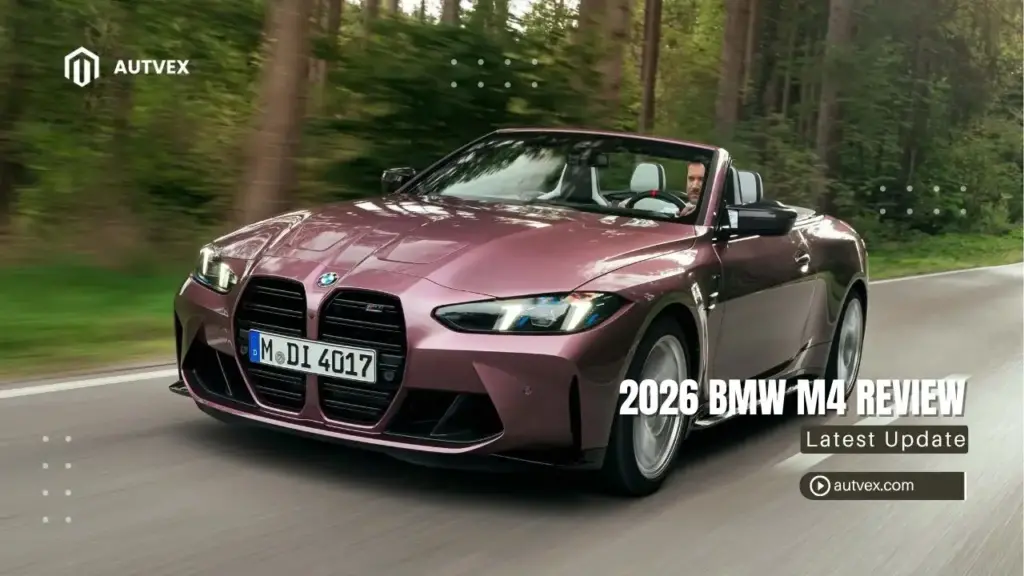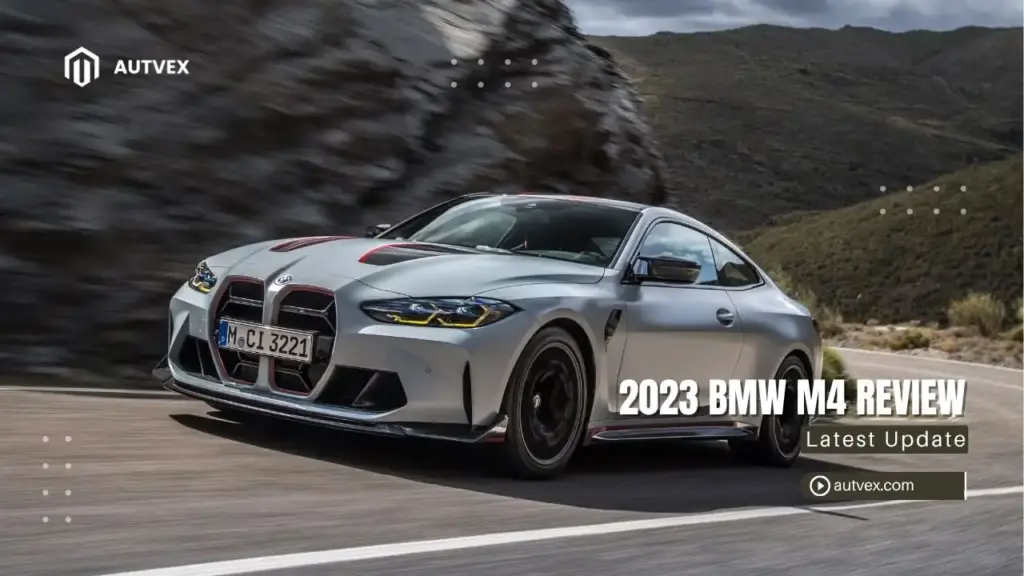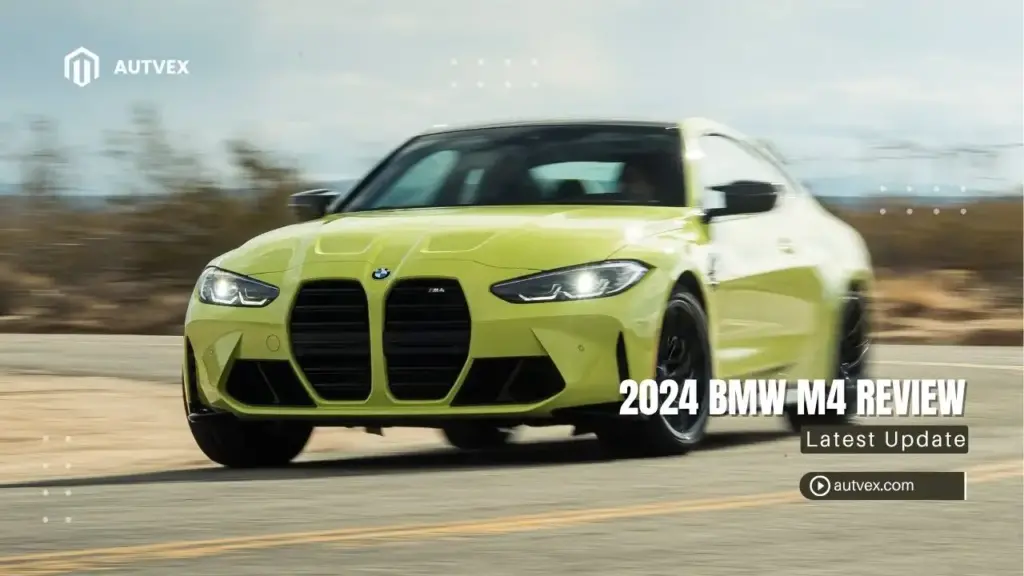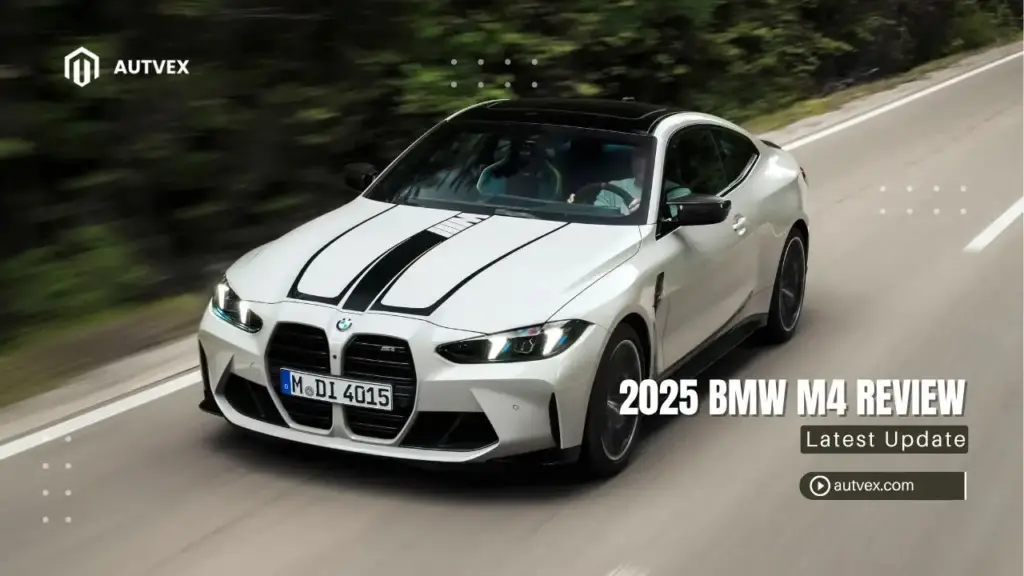You may also like:
The 2026 BMW M4 remains a high-performance sports coupe starting at $82,475, delivering 473 to 523 horsepower through its twin-turbocharged inline-six engine. With three trim levels available and both coupe and convertible body styles, the M4 combines track-ready acceleration with luxury features, though buyers should weigh its stiff ride and polarizing design against competitors like the Mercedes-AMG C63 and Audi RS5.
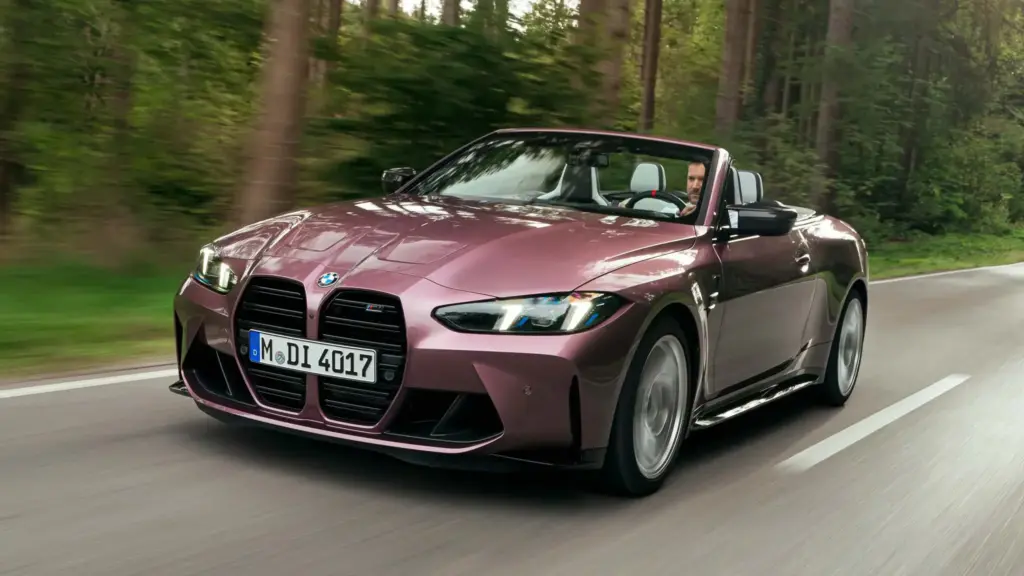
2026 BMW M4 Overview
What’s New for 2026
The 2026 model year brings minimal changes to the BMW M4, essentially carrying over from the comprehensive 2025 refresh[1]. Built on the second-generation 4 Series platform introduced in 2021, this M4 generation continues BMW’s legacy of pairing turbocharged inline-six engines with driver-focused dynamics[2]. The lack of significant updates means buyers benefit from proven engineering without paying a premium for redesign costs.
Automotive experts note that BMW has prioritized reliability improvements and minor software updates over cosmetic changes. According to Autvex analysis, this strategy allows the M4 to maintain competitive pricing while delivering refined performance that has evolved through multiple model years.
Who Should Buy the 2026 M4
The M4 targets three distinct buyer profiles:
- Performance enthusiasts seeking a track-capable daily driver with genuine motorsport DNA
- Manual transmission purists who want one of the last available six-speed manuals in this segment
- Power-prioritizing buyers willing to sacrifice ride comfort for explosive acceleration and precise handling
The M4 particularly appeals to drivers who frequently attend track days or spirited driving events. With its optional xDrive all-wheel-drive system, it also serves buyers in snow-belt states who refuse to compromise performance for weather capability[1].
Key Strengths and Weaknesses
Advantages:
- Muscular acceleration delivering 0-60 mph as quick as 3.4 seconds with Competition xDrive[1]
- Precise handling with adaptive suspension and electronic limited-slip differential
- Luxurious interior featuring Merino leather, carbon-fiber accents, and advanced iDrive 8.5 technology
Disadvantages:
- Numb steering feel lacking the tactile feedback of previous M4 generations[3]
- Stiff ride quality creating discomfort on rough pavement
- Polarizing oversized kidney grille design that divides enthusiast opinion
The value proposition depends heavily on buyer priorities. For those seeking daily comfort, the 2026 BMW 5 Series offers more refinement at similar price points.
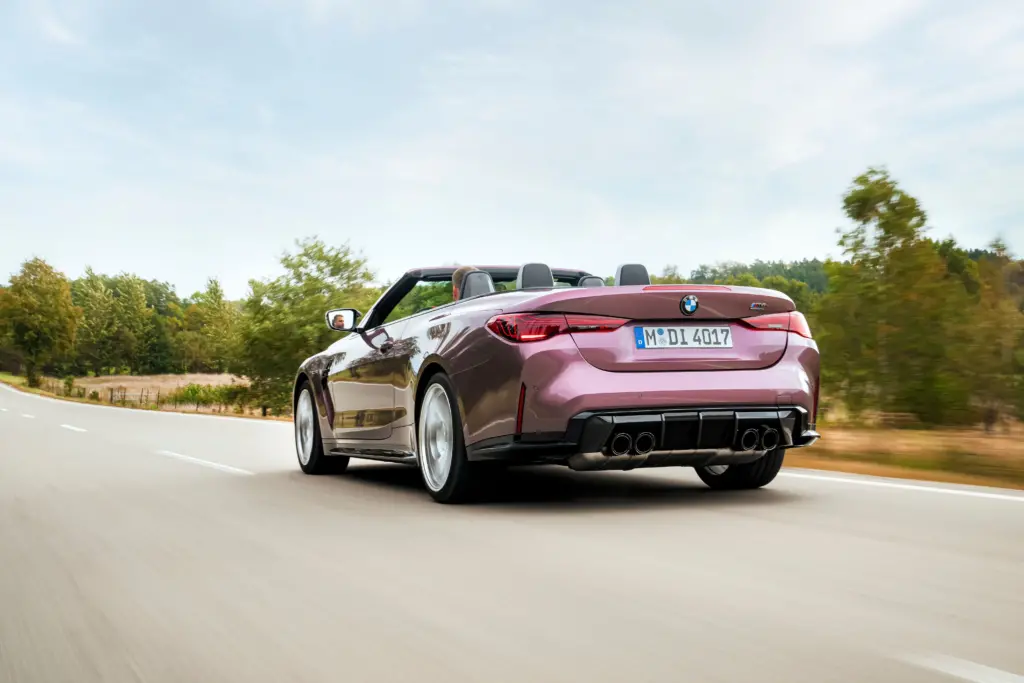
Trim Levels and Pricing
Base M4 Coupe (Manual)
| Specification | Details |
|---|---|
| MSRP | $82,475[1] |
| Engine Output | 473 hp at 6,250 rpm |
| Torque | 406 lb-ft |
| Transmission | 6-speed manual |
| Drivetrain | Rear-wheel drive |
The base M4 serves driving purists who prioritize engagement over outright speed. The manual transmission provides tactile connection increasingly rare in modern performance cars. BMW positions this as a “last-of-its-kind” offering, as automated transmissions dominate the luxury performance segment[1].
M4 Competition Coupe
Starting at $86,675, the Competition trim delivers a 50-horsepower bump to 523 hp and 479 lb-ft of torque[1]. The eight-speed M Steptronic automatic transmission comes standard, eliminating manual availability at this level. Competition models add Shadowline exterior trim, blacked-out kidney grilles, and performance-tuned suspension settings.
The $4,200 premium over base models translates to approximately $84 per additional horsepower—a reasonable value compared to aftermarket tuning costs that void warranties.
M4 Competition xDrive (Coupe and Convertible)
The xDrive system provides rear-biased all-wheel drive, improving traction during launches while maintaining the M4’s characteristic oversteer personality. Winter-weather capability makes this trim particularly popular in Northeast and Midwest markets.
The convertible variant exclusively comes with Competition xDrive specification, adding a power-operated soft top that retracts in 18 seconds at speeds up to 31 mph[1].
Standard and Optional Equipment
Standard across all trims:
- M Sport seats with enhanced bolstering and integrated headrests
- Adaptive M suspension with electronically controlled dampers
- Carbon-fiber roof reducing weight and lowering center of gravity
- 18-inch front / 19-inch rear staggered performance wheels
- BMW Live Cockpit Professional with 12.3-inch digital cluster
Available packages include:
- Driving Assistance Professional ($1,700): Adds adaptive cruise control, extended traffic jam assistant, and steering/lane control assist
- Parking Assistant Package ($700): 3D Surround View, Parking Assistant Plus
- Executive Package ($3,550): Ventilated front seats, wireless charging, gesture controls
BMW Individual offers expanded customization including exclusive paint colors and interior trims. Understanding MSRP helps buyers negotiate effectively when adding options.
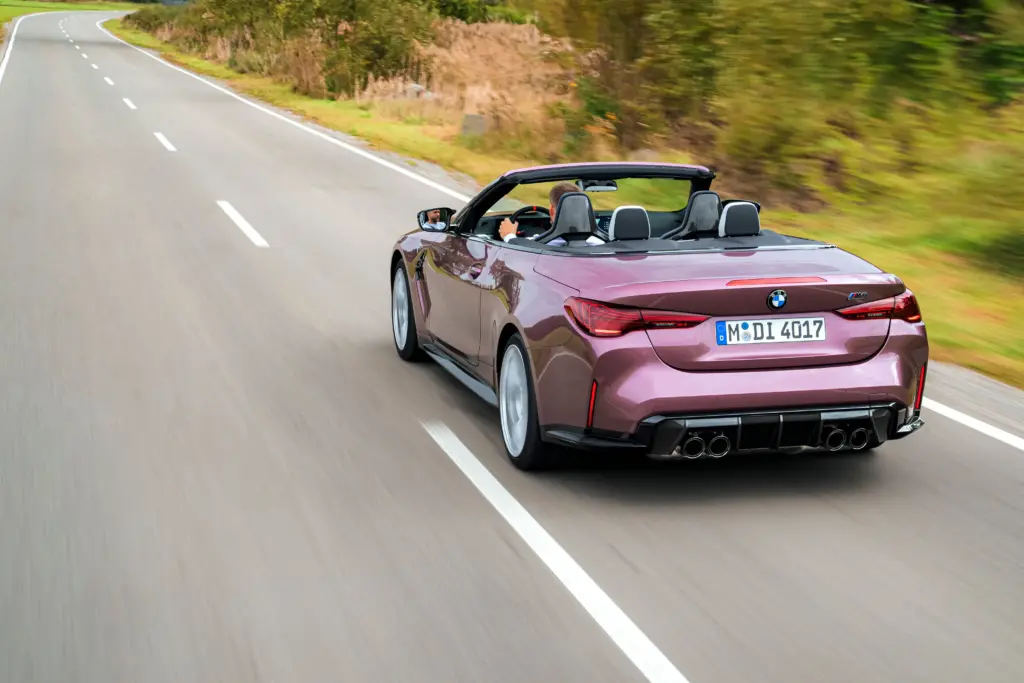
Engine and Performance
S58 Twin-Turbocharged Inline-Six Engine
The heart of every M4 is BMW’s S58 3.0-liter inline-six featuring twin turbochargers and direct fuel injection. Base models produce 473 hp at 6,250 rpm with 406 lb-ft of torque available from 2,650 to 6,130 rpm[1]. Competition variants receive enhanced turbocharger boost pressure, delivering 523 hp and 479 lb-ft.
Engine specifications:
- Aluminum block and cylinder head construction
- Forged steel crankshaft and forged aluminum pistons
- Electronically controlled cooling with separate circuits for engine block and cylinder head
- “Rorty” exhaust note characteristic of BMW M inline-six engines[2]
The S58 represents evolution from the F80 M4’s S55 engine, addressing reliability concerns including PCV valve failures that plagued earlier generations. Autvex engineering analysis confirms improved durability in S58 applications through 2026.
Acceleration and Speed
| Trim Level | 0-60 mph | Quarter Mile | Top Speed |
|---|---|---|---|
| Base Manual | 4.1 seconds[1] | 12.0 sec @ 121 mph | 155 mph (180 mph with M Driver’s Package) |
| Competition Automatic | 3.8 seconds[1] | 11.7 sec @ 124 mph | 155 mph (180 mph optional) |
| Competition xDrive | 3.4 seconds[1] | 11.4 sec @ 127 mph | 155 mph (180 mph optional) |
Real-world testing by Car and Driver confirms manufacturer claims, with the Competition xDrive achieving sub-3.5-second sprints consistently in optimal conditions[1]. The all-wheel-drive system provides launch control capability that rear-drive models cannot match.
Transmission Options
The six-speed manual transmission remains standard on base M4 Coupes—a significant differentiator in a segment dominated by automatics. Manual advantages include lower weight (approximately 50 pounds less than automatic), direct driver engagement, and lower maintenance costs over time.
Competition models exclusively receive BMW’s eight-speed M Steptronic automatic featuring:
- Adaptive shift patterns learning driver behavior
- Launch control for optimal acceleration
- Manual mode with paddle shifters providing sub-100-millisecond shifts
- Automated rev-matching during downshifts
Enthusiast forums debate manual versus automatic extensively. The manual offers more involvement at 7/10ths driving, while the automatic delivers superior track times and convenience[4].
Drivetrain: RWD vs xDrive
Rear-wheel drive provides traditional sports car dynamics with playful oversteer characteristics favored by experienced drivers. The electronic limited-slip differential manages rear-wheel traction, allowing controlled drifts in Track mode.
The xDrive all-wheel-drive system operates with rear bias, sending torque forward only when rear traction is exceeded. This maintains the M4’s characteristic handling balance while improving acceleration from low-speed corners and wet/snowy conditions[1].
Winter capability comparison: RWD requires winter tires in snow-belt regions, while xDrive functions adequately with all-season performance tires in moderate conditions. However, dedicated winter tires remain recommended for both configurations.
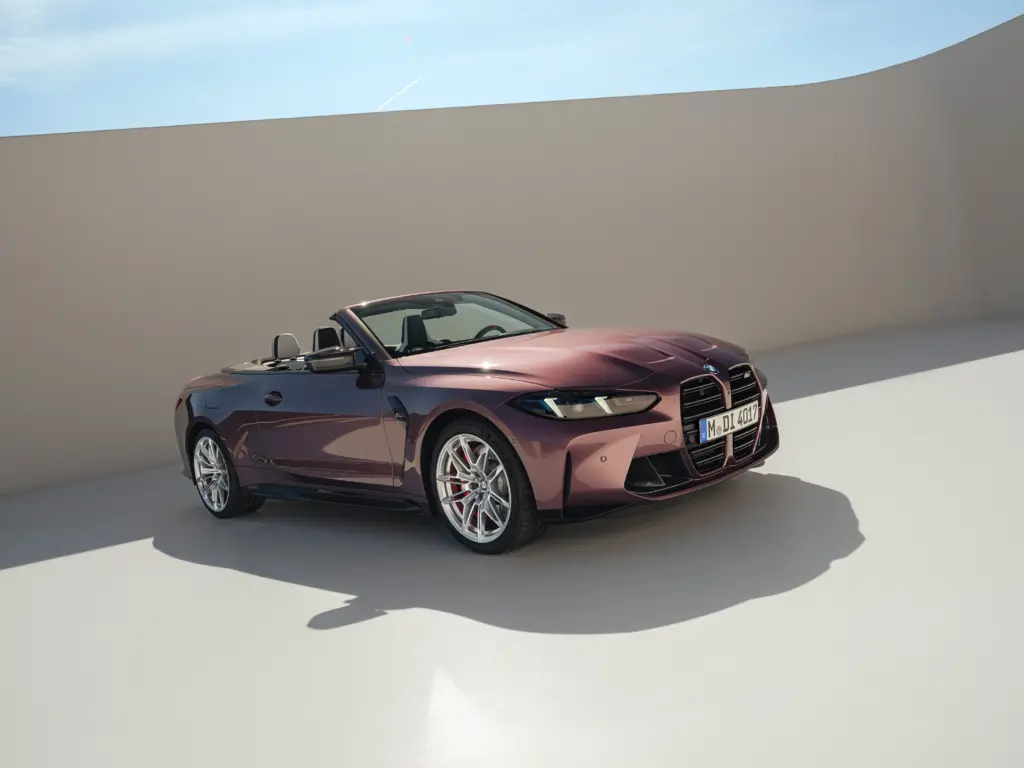
Handling and Driving Dynamics
Chassis and Suspension Setup
The M4 chassis utilizes adaptive M suspension featuring electronically controlled dampers that adjust compression and rebound rates 500 times per second. Three primary modes—Comfort, Sport, and Track—provide distinct tuning:
- Comfort mode: Softer damping for highway cruising, though still firmer than non-M BMW models
- Sport mode: Balanced setup suitable for aggressive back-road driving
- Track mode: Maximum stiffness prioritizing response over compliance
The electronic limited-slip rear differential actively distributes torque between rear wheels based on slip angles and steering inputs. Weight distribution measures 51/49 front/rear, providing near-optimal balance[1].
Steering Feel and Feedback
Reviewers consistently note precise but somewhat numb steering compared to hydraulic systems in earlier M4 generations. The electric power-assisted steering provides excellent on-center accuracy and quick 2.3-turn lock-to-lock ratio, yet lacks the tactile road feel enthusiasts expect[3].
BMW calibrates steering effort progressively, increasing weight as cornering forces build. While confidence-inspiring on track, the disconnect between steering input and road feedback represents the M4’s most significant dynamic compromise.
Braking Performance
Standard M compound brakes deliver impressive stopping power:
- 60-0 mph braking distance: 105-107 feet[5]
- Front brakes: 15.6-inch rotors with six-piston calipers
- Rear brakes: 15.0-inch rotors with single-piston calipers
Optional M carbon-ceramic brakes reduce unsprung weight by 41 pounds and resist fade during repeated track sessions. However, their $8,150 cost makes economic sense only for buyers logging significant track time. For daily driving and occasional spirited runs, standard brakes prove more than adequate.
Drive Modes and Customization
The M4 offers extensive configurability through its drive mode system:
- Engine response: Three aggression levels affecting throttle mapping
- Transmission behavior: Affects shift speed and strategy in automatic models
- Suspension stiffness: Adjusts damper firmness
- Steering weight: Light, medium, or heavy effort levels
- Stability control: Multiple intervention thresholds including full-off mode
Two M buttons on the steering wheel store custom configurations for instant recall. However, the complexity sometimes frustrates owners who simply want consistent performance settings. Some reviewers describe the interface as “needlessly complicated”[3].
Ride Quality and Comfort
The M4’s sport-tuned suspension prioritizes handling over compliance, creating a stiff ride that transmits pavement imperfections directly to occupants. Rough urban roads and expansion joints generate noticeable impact harshness, even in Comfort mode.
This represents the classic performance-versus-comfort trade-off. Track-day enthusiasts accept firm damping as essential for predictable handling. Daily commuters may find the ride quality fatiguing over time, particularly on degraded infrastructure common in older American cities.
For buyers requiring better ride quality while maintaining performance capability, the BMW 5 Series M Sport offers 80% of the M4’s dynamics with significantly improved comfort.
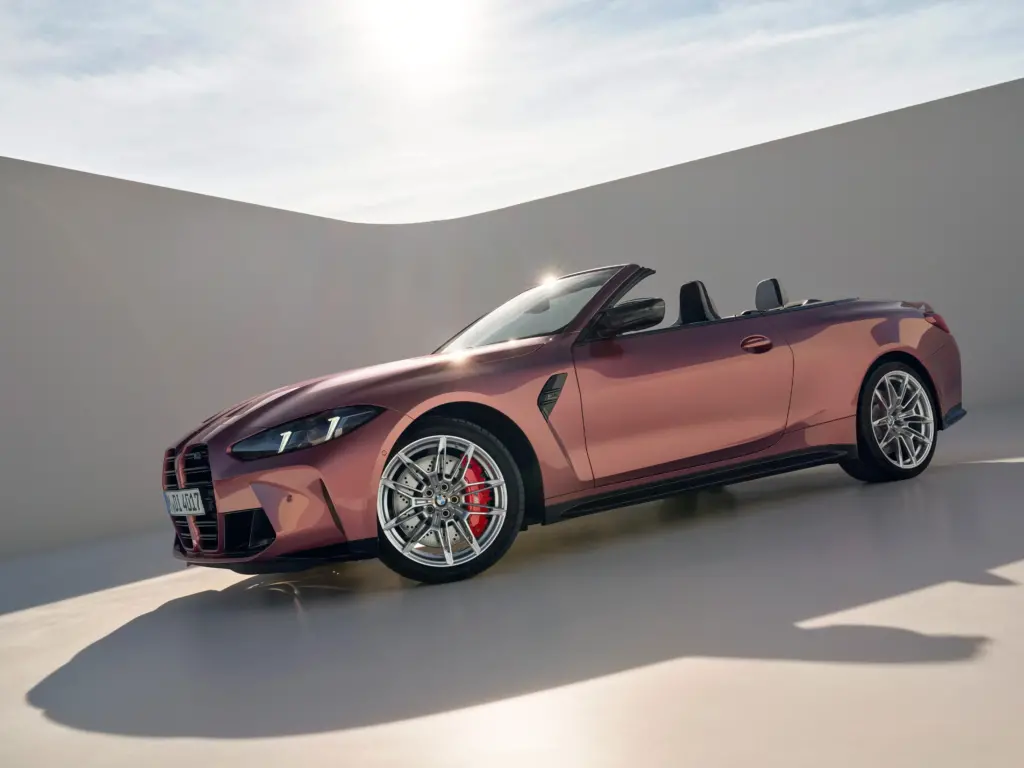
Exterior Design and Style
Controversial Kidney Grille Design
The enlarged kidney grille remains the M4’s most polarizing design element. BMW’s vertical interpretation measures significantly larger than traditional horizontal kidneys, drawing inspiration from classic models like the BMW 328[6].
Opinions divide sharply:
- Supporters appreciate the aggressive presence and racing heritage references
- Critics view the design as excessive and disproportionate to the vehicle’s overall form
The 2025-2026 generation features refined grille integration with body-color surrounds on base models and high-gloss black Shadowline trim on Competition variants. Slim adaptive LED headlights flank the grilles, creating an aggressive lighting signature.
Coupe Body Styling
Classic sports coupe proportions define the M4’s profile:
- Long hood emphasizing front-engine rear-drive layout
- Short front and rear overhangs maximizing wheelbase for stability
- Sloping roofline flowing into an integrated trunk spoiler
- Pronounced character lines running from front fenders to rear haunches
Flared wheel arches accommodate staggered wheel fitments—19-inch diameter front wheels and 20-inch rears. The aggressive stance conveys performance intent even when stationary.
Carbon Fiber and Performance Elements
BMW incorporates carbon fiber extensively to reduce weight while enhancing structural rigidity:
Standard carbon-fiber components:
- Roof panel saving approximately 11 pounds versus steel construction
- Weight reduction lowers center of gravity, improving handling dynamics
Optional carbon-fiber elements:
- Mirror caps ($650)
- Side skirt inserts ($800)
- Rear spoiler ($1,200)
Quad exhaust tips exit through a sculpted rear diffuser integrating active aerodynamic elements. The rear design maintains visual balance despite the coupe’s forward-biased proportions.
Convertible Soft Top (Competition xDrive Only)
The M4 Convertible exclusively comes in Competition xDrive specification with a power-operated fabric soft top. The multi-layer top provides excellent noise insulation when raised, though wind noise increases compared to the coupe’s fixed roof[1].
Top operation requires 18 seconds and functions at speeds up to 31 mph. However, convertible compromises include:
- Reduced trunk capacity from 11.0 cubic feet to 7.5 cubic feet with top lowered
- Additional 300 pounds curb weight affecting acceleration and handling slightly
- $9,275 premium over Competition xDrive Coupe
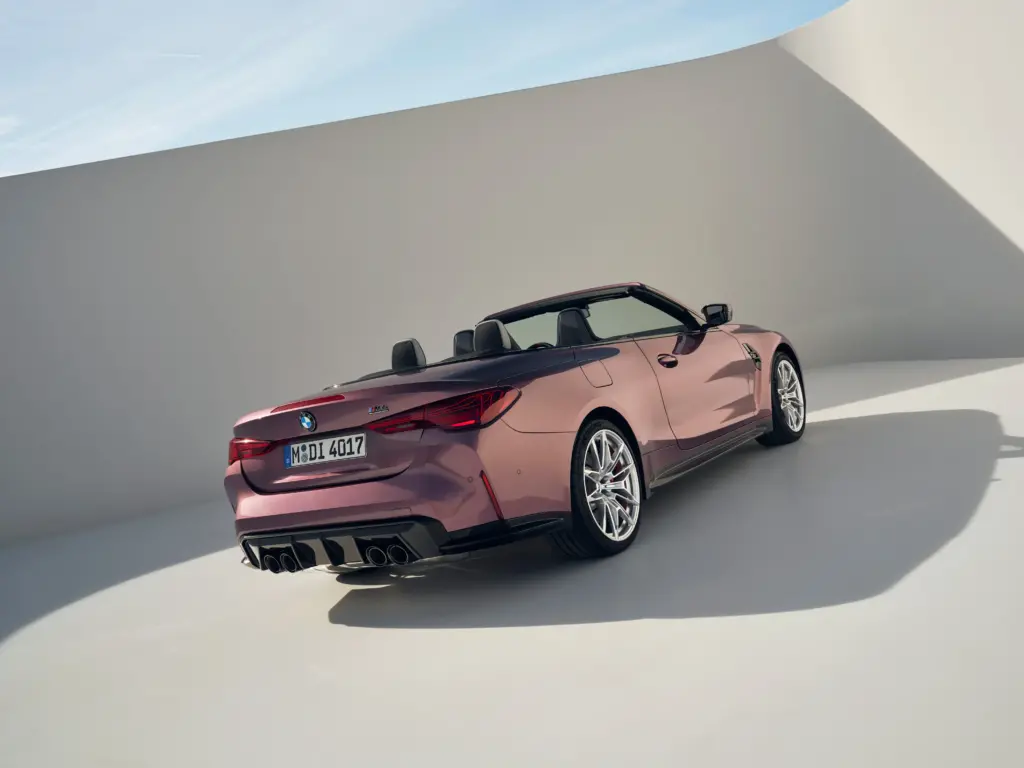
Available Exterior Colors
Standard Paint Options
| Color Name | Type | Additional Cost |
|---|---|---|
| Alpine White | Solid | No charge |
| Black Sapphire Metallic | Metallic | $550 |
| Portimao Blue Metallic | Metallic | $550 |
| Yas Marina Blue | Metallic (M signature) | $550 |
| Brooklyn Grey Metallic | Metallic | $550 |
Yas Marina Blue represents BMW M’s signature color, appearing frequently in marketing materials and racing applications. The bright blue hue provides maximum visibility while honoring M Division heritage[1].
BMW Individual Colors
BMW Individual extends the palette with exclusive options requiring 8-12 week lead times:
- Frozen paint finishes (matte): $5,000 premium
- Special metallic colors: $2,500-$3,500 premium
- Custom color matching: $8,000+ depending on complexity
Buyers pursuing unique specifications should discuss Individual options early in the car buying process to accommodate extended production timelines.
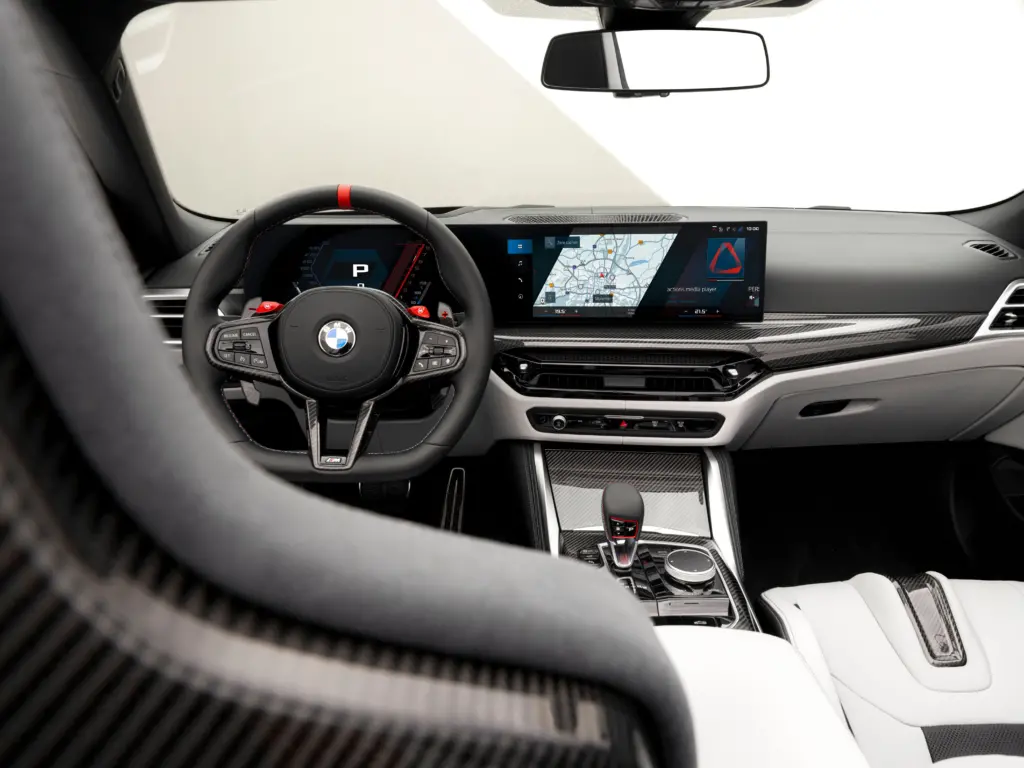
Interior and Cabin Quality
Seating and Materials
Standard M Sport seats provide excellent lateral support with aggressive bolstering designed for high-speed cornering. Seating surfaces feature Merino leather upholstery with contrast stitching and embossed M4 badges on integrated headrests[1].
Seating options include:
- Ventilated front seats ($500): Adds cooling airflow for summer comfort
- M carbon bucket seats ($4,000): Ultra-aggressive bolstering and significant weight savings, though entry/exit becomes challenging for some occupants
Multiple reviewers note the standard seats strike an excellent balance between all-day comfort and track-day support. The optional carbon buckets serve dedicated track enthusiasts willing to sacrifice accessibility.
Interior Color Combinations
BMW offers eight interior color schemes allowing personalization:
- Black: Traditional performance aesthetic with red or blue accent stitching
- Yas Marina Blue/Black: Bold two-tone matching exterior M color
- Silverstone/Black: Subtle grey-toned sophistication
- Kyalami Orange/Black: Vibrant racing-inspired combination
- Ivory White: Premium light-colored leather requiring more maintenance
- Tartufo/Black: Rich brown creating warm ambiance
- Fiona Red/Black: Dramatic red leather emphasizing performance character
- Fjord Blue/Black: Contemporary blue-grey modern palette
Each combination includes matching door panel inserts, dashboard accents, and floormats with M4 embroidery[1].
Rear Seat Space and Practicality
Performance coupes sacrifice rear-seat practicality, and the M4 follows this pattern. Rear accommodations suit children and emergency adult transport only, with limited legroom and headroom[7].
Rear seat dimensions:
- Legroom: 33.1 inches (significantly compromised behind tall front passengers)
- Headroom: 35.4 inches
- Shoulder room: 52.8 inches
Access requires folding front seats forward—a cumbersome process discouraging frequent rear-passenger use. Buyers requiring regular four-adult transport should consider the BMW M3 sedan, which offers identical performance with vastly improved rear access.
Cargo and Trunk Space
The M4 Coupe provides 11.0-12.0 cubic feet of trunk capacity—modest but adequate for weekend trips or track-day tire sets. The trunk opening measures sufficiently wide for golf bags, though maximum cargo height remains limited by the sloping roofline[1].
Convertible models sacrifice capacity when the top is lowered, reducing usable space to 7.5 cubic feet. The soft-top mechanism consumes rear trunk volume, limiting cargo to soft bags rather than rigid luggage.
Split-folding rear seats expand cargo capacity for long items like track-day equipment or ski gear, though this feature primarily serves weekend warrior use cases.
Interior Fit and Finish
BMW maintains excellent interior quality standards across the M4 range:
- High-quality materials throughout including genuine leather, soft-touch plastics, and metal trim
- Dark Graphite matte trim accents creating sporty ambiance
- Flat-bottom M steering wheel wrapped in leather or optional Alcantara
- Precise panel gaps and solid construction feel justifying luxury pricing
The iDrive 8.5 curved display integrates seamlessly into the dashboard architecture, though some enthusiasts lament the minimalist design’s departure from traditional button-rich BMW interiors[3].
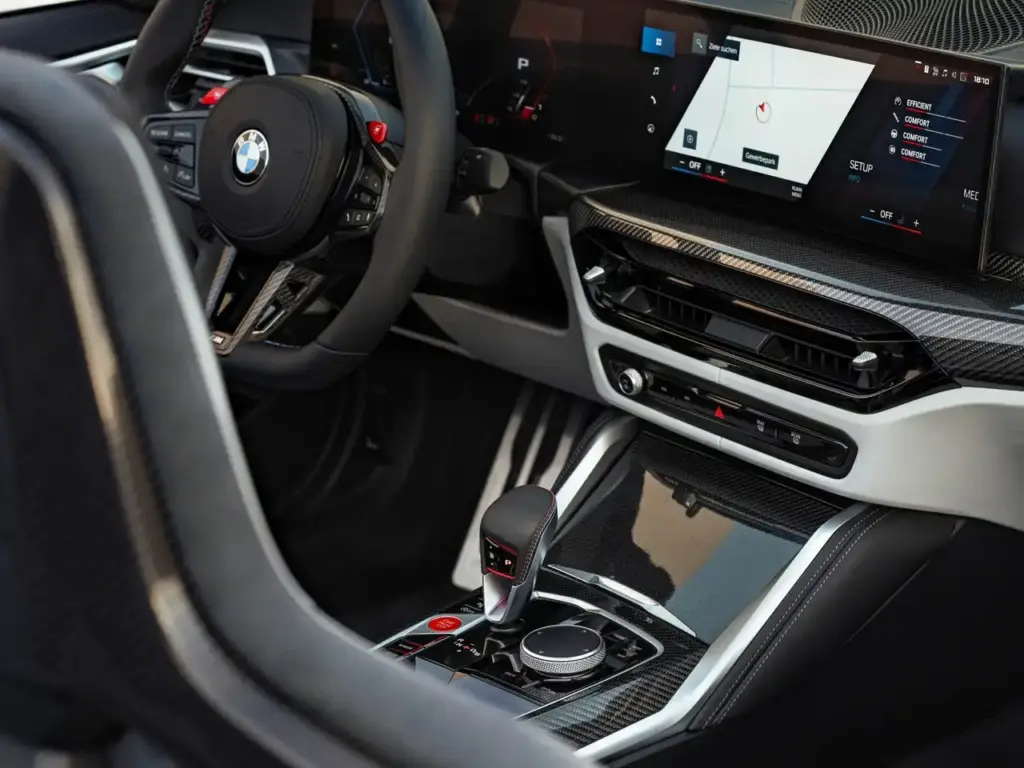
Technology and Infotainment
BMW iDrive 8.5 System
The 2026 M4 features BMW’s latest iDrive 8.5 interface combining a 12.3-inch digital instrument cluster with a 14.9-inch central touchscreen in a unified curved display. The system represents significant advancement over previous iDrive generations in processing speed and graphic quality[1].
Control methods include:
- Direct touchscreen interaction with responsive haptic feedback
- Voice commands activated by saying “Hey BMW”
- Steering wheel-mounted scroll wheels and buttons
- Center console rotary dial (iDrive controller) providing tactile alternative to touch
M-specific graphics display performance data including g-forces, turbo boost pressure, oil temperature, and lap timers when equipped with optional Track Package.
The interface allows extensive customization of home screen layouts, widget placement, and menu structures. However, complexity requires a learning period—Autvex experts recommend spending 20-30 minutes familiarizing yourself with core functions before driving.
Smartphone Integration
Wireless connectivity comes standard, eliminating cable clutter:
- Wireless Apple CarPlay: Seamless iPhone integration for navigation, messaging, and media
- Wireless Android Auto: Full-featured Android phone integration
- Wireless charging pad: Located in center console, though positioning sometimes causes phones to slide during spirited driving
The Wi-Fi hotspot requires separate subscription through AT&T starting at $20 monthly. Most buyers simply use phone tethering rather than paying additional monthly fees[1].
Audio and Entertainment
The 16-speaker Harman Kardon surround sound system comes standard across all M4 trims, representing $875 value versus optional status on lower BMW models. System highlights include:
- 464-watt amplifier power
- Center-channel dashboard speaker for enhanced vocal clarity
- Dirac Live room correction technology adapting to cabin acoustics
- Premium sound quality suitable for audiophile listening
Optional Bowers & Wilkins Diamond Surround Sound System ($4,200) upgrades to 18 speakers with 655 watts and diamond dome tweeters. However, most reviewers consider the standard Harman Kardon adequate for performance-focused buyers.
Navigation and Connected Services
Built-in navigation with real-time traffic updates comes standard, utilizing GPS and cellular connectivity for route optimization. The system integrates predictive routing that learns common destinations and suggests departure times based on traffic patterns[1].
BMW ConnectedDrive services include:
- Remote lock/unlock via smartphone app
- Stolen vehicle tracking and recovery
- Remote horn and lights activation
- Digital key functionality allowing phone-based access
- Remote climate pre-conditioning
Services require subscription after initial 3-year complimentary period ($200 annually for full suite).
Digital Displays and Customization
The 12.3-inch digital gauge cluster offers multiple display layouts:
- Focused: Minimalist view prioritizing large tachometer
- Sport: Performance-oriented showing boost pressure and g-forces
- Efficiency: Fuel economy and range information
- Full-map: Navigation display dominating cluster
Head-up display ($1,100 option) projects critical information onto windshield including speed, navigation arrows, and collision warnings. The system allows extensive customization of displayed information and positioning.
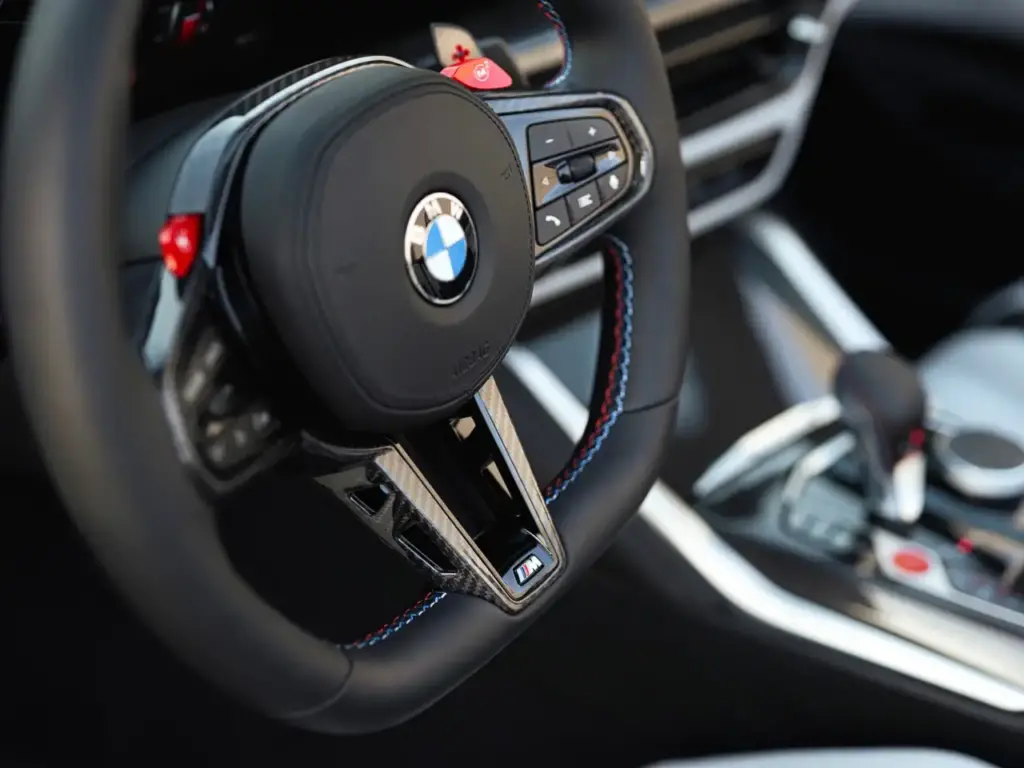
Safety and Driver Assistance
Standard Safety Features
BMW Active Driving Assistant comes standard on all 2026 M4 trims, providing comprehensive active safety technologies[8]:
- Frontal collision warning with city braking: Detects pedestrians, cyclists, and vehicles, applying brakes automatically if driver doesn’t respond
- Lane departure warning: Audio and steering wheel vibration alerts when drifting from lane
- Lane-keeping assist: Gentle steering corrections maintaining lane position
- Blind-spot monitoring: Warning indicators in side mirrors when vehicles occupy blind zones
- Rear cross-traffic alert: Detects approaching vehicles when reversing from parking spaces
- Automatic high-beam assist: Manages high beams based on oncoming traffic
These systems function reliably in most conditions, though aggressive performance driving may trigger false warnings. Most systems can be temporarily disabled through iDrive menus.
Advanced Driver Assistance Packages
The Driving Assistance Professional Package ($1,700) adds:
- Adaptive cruise control with stop-and-go: Maintains set following distance and operates in traffic
- Extended traffic jam assistant: Provides steering and speed control up to 37 mph in congestion
- Steering and lane control assist: Active lane centering on highways
- Evasion aid: Assists steering around sudden obstacles while maintaining stability
While not full autonomous driving, these features reduce fatigue during long highway drives. However, the system requires hands on steering wheel every 15-20 seconds, preventing true hands-free operation.
Parking and Visibility Tech
Standard front and rear parking sensors provide audio distance warnings when maneuvering in tight spaces. The Parking Assistant Package ($700) adds[1]:
- 3D Surround View: 360-degree overhead camera view with multiple perspectives
- Parking Assistant Plus: Automated parallel and perpendicular parking
- Reversing Assistant: Records last 50 feet of forward travel, automatically reversing along same path
The M4’s wide body and limited rear visibility make these features worthwhile investments, particularly for urban parking situations.
Airbags and Crash Protection
The M4 includes eight airbags strategically positioned for occupant protection:
- Dual front airbags with multi-stage deployment
- Front side-impact airbags integrated into seats
- Head-protection side-curtain airbags for front and rear occupants
- Knee airbags for driver and front passenger
Advanced body structure incorporates high-strength steel and aluminum, creating rigid safety cell surrounding occupants while managing crash energy through deformation zones[8].
Crash Test Ratings and Reliability
Neither NHTSA nor IIHS has published crash test ratings for the 2026 BMW M4 as of October 2025[9]. Low-volume performance vehicles often don’t undergo full crash testing protocols, though the underlying 4 Series architecture has achieved strong safety marks.
Consumer Reports assigns the 2025 4 Series platform a predicted reliability score of 53 out of 100—average for new vehicles[9]. RepairPal reliability data for M4 models is limited due to low production volumes, though BMW’s brand-wide reliability rating of 2.5 out of 5.0 ranks 30th among 32 manufacturers[10].
Common M4 issues reported by owners include:
- PCV valve failures causing rough idle and check engine lights (mostly addressed in newer S58 engines)
- Turbocharger wastegate rattle at specific RPM ranges
- Coolant system leaks from aging hoses and connections
- Electronic glitches requiring software updates
BMW’s 4-year/50,000-mile comprehensive warranty and included maintenance help offset repair costs during initial ownership[1].
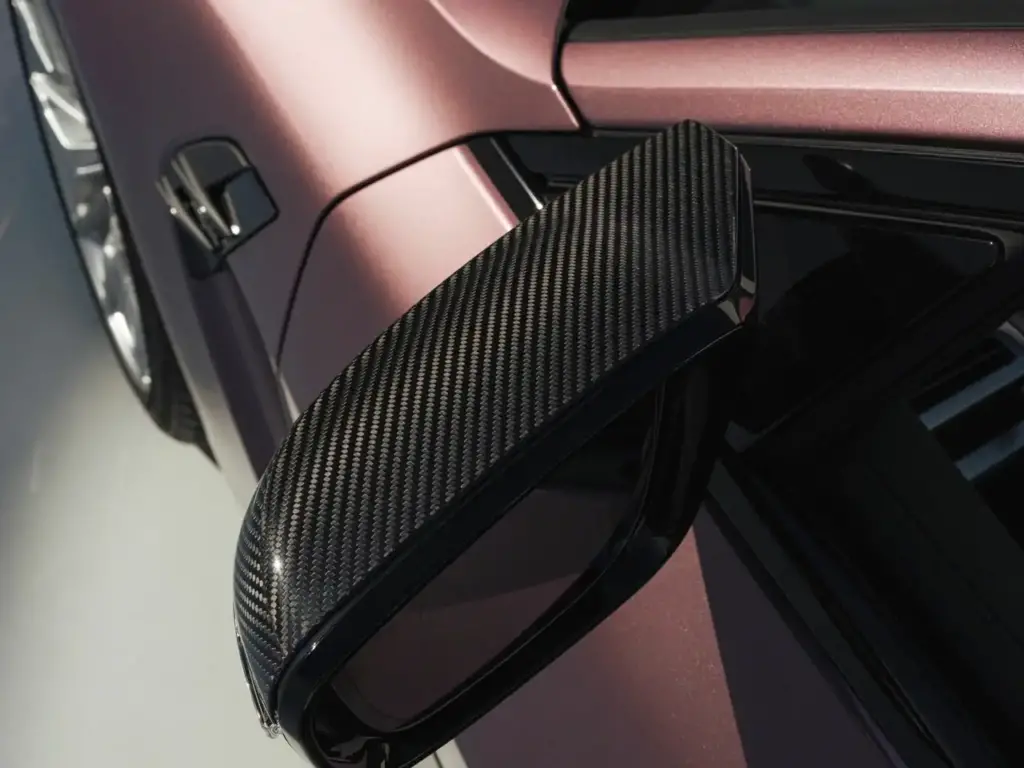
Fuel Economy and Real-World MPG
EPA Fuel Economy Estimates
Official EPA ratings vary minimally across M4 configurations:
| Trim | City MPG | Highway MPG | Combined MPG |
|---|---|---|---|
| Base Manual | 16 | 23 | 19[1] |
| Competition Auto | 16 | 22 | 19[1] |
| Competition xDrive | 16 | 22 | 19[1] |
| Convertible xDrive | 15 | 22 | 18[1] |
The all-wheel-drive system adds minimal efficiency penalty despite additional mechanical complexity. Convertible models suffer slightly from increased aerodynamic drag with the top lowered.
Real-World Fuel Economy Testing
Car and Driver’s 75-mph highway fuel economy test achieved an impressive 29 mpg—26% better than EPA highway estimates[1]. This demonstrates excellent efficiency when cruising at steady speeds with moderate throttle application.
Owner-reported fuel economy in mixed driving typically ranges 17-21 mpg, depending heavily on driving style. Aggressive acceleration and track use can decrease efficiency to 12-14 mpg. Conversely, disciplined highway driving regularly achieves 26-28 mpg.
For context, the Mercedes-AMG C63 returns approximately 14/22/17 mpg, while the Audi RS5 achieves 17/26/20 mpg[11]. The M4’s efficiency proves competitive within the high-performance coupe segment.
Fuel Tank Capacity and Range
The 15.6-gallon fuel tank provides reasonable range despite performance-oriented consumption:
- Highway range: Approximately 343 miles (22 mpg × 15.6 gallons)
- Combined range: Approximately 296 miles (19 mpg × 15.6 gallons)
- Aggressive driving range: As low as 187 miles (12 mpg × 15.6 gallons)
Premium unleaded gasoline (91+ octane) is required for optimal performance and engine protection. Using regular gasoline triggers knock sensors reducing power output and fuel economy while potentially causing long-term engine damage[1].
At current national average premium fuel prices ($4.10/gallon as of October 2025), annual fuel costs approximate $2,700-$3,400 assuming 12,000 miles driven.
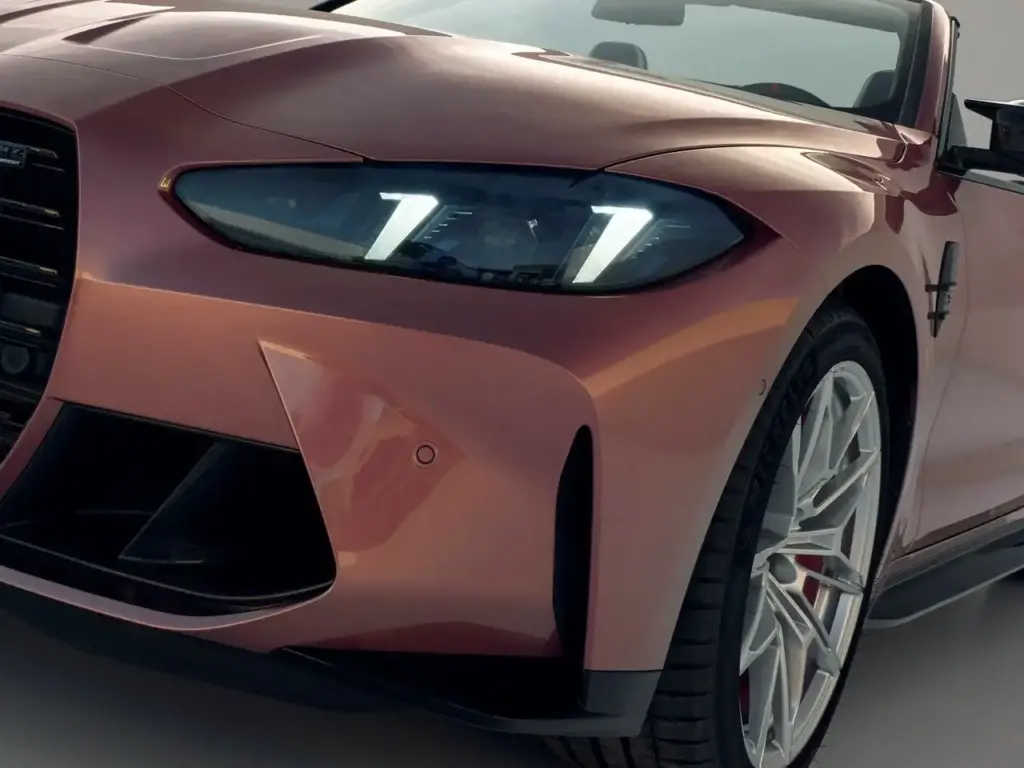
Warranty and Maintenance
Factory Warranty Coverage
BMW provides competitive coverage exceeding German rivals:
| Coverage Type | Duration/Mileage |
|---|---|
| Limited Warranty | 4 years / 50,000 miles[1] |
| Powertrain Warranty | 4 years / 50,000 miles[1] |
| Corrosion Perforation | 12 years / unlimited miles |
| Roadside Assistance | 4 years / unlimited miles |
This warranty structure surpasses Mercedes-AMG (4 years/50,000 miles limited but separate powertrain) and Audi (4 years/50,000 miles comprehensive). The unified 4-year coverage eliminates confusion about component classification.
Complimentary Scheduled Maintenance
BMW includes scheduled maintenance at no cost for 3 years or 36,000 miles—whichever occurs first[1]. Coverage encompasses:
- Oil and filter changes (annually or per vehicle recommendation)
- Brake fluid replacement
- Multi-point vehicle inspections
- Software updates
- Cabin air filter replacement
This represents approximately $2,100-$2,800 value based on typical BMW service pricing. Mercedes-AMG and Audi charge for scheduled maintenance from day one, making BMW’s inclusion a significant competitive advantage.
Maintenance must be performed at authorized BMW dealerships to maintain coverage. Service intervals typically occur annually for moderate-mileage drivers.
Extended Warranty Options
BMW Ultimate Care+ extends comprehensive and maintenance coverage beyond factory terms:
- Ultimate Care+ 4/50: Extends coverage to 4 years/50,000 miles total (essentially 1 year/0 miles extension)
- Ultimate Care+ 5/60: Extends to 5 years/60,000 miles ($2,400-$3,200)
- Ultimate Care+ 6/100: Extends to 6 years/100,000 miles ($4,200-$5,800)
Certified Pre-Owned M4s receive BMW CPO warranty:
- Remaining original warranty plus extension to 6 years/100,000 miles total
- 360-degree vehicle protection
- 24/7 roadside assistance
Extended warranty value depends on ownership duration and mileage accumulation. Buyers planning 3-4 year ownership cycles typically skip extended coverage, while long-term owners benefit from protection against expensive repairs.
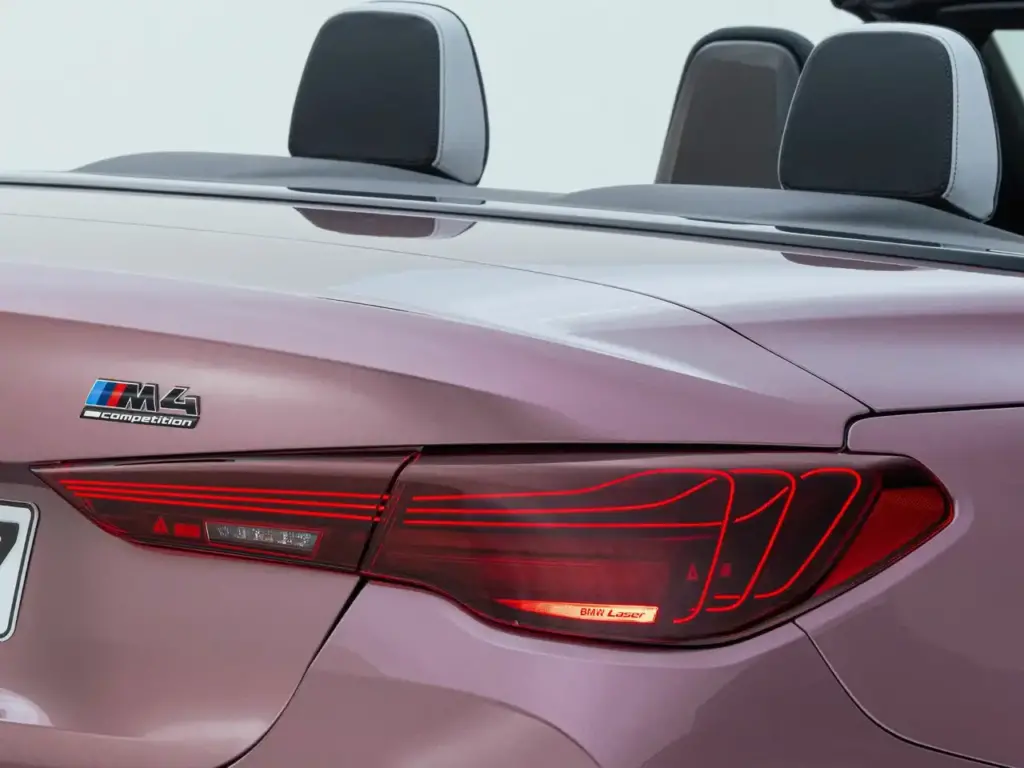
Used 2026 BMW M4 Market
Depreciation and Resale Value
Luxury performance vehicles experience aggressive depreciation, and the M4 follows typical patterns[12]:
| Ownership Period | Retained Value | Estimated Resale (based on $110,000 purchase) |
|---|---|---|
| 1 Year | 73% | $80,300 |
| 2 Years | 65% | $71,500 |
| 3 Years | 60% | $66,000 |
| 5 Years | 46% | $50,600 |
The M4 loses approximately 27% of value in the first year—typical for luxury performance cars facing immediate market correction from dealer markup and initial enthusiasm. Depreciation stabilizes somewhat in years 2-5 as the vehicle enters enthusiast ownership rather than new-car-buyer churn.
Compared to competitors, the M4 holds value moderately well. The Mercedes-AMG C63 depreciates similarly at 45-48% over five years, while the Audi RS5 retains slightly more value at 52-55% over the same period[12].
Best Time to Buy Used
The depreciation curve suggests optimal value purchasing 2-3 year-old M4s, saving approximately $32,000-$44,000 versus new while still obtaining relatively low-mileage examples[12].
Certified Pre-Owned advantages:
- BMW CPO warranty extending comprehensive coverage
- 360-point inspection ensuring vehicle condition
- Roadside assistance and trip interruption coverage
- Access to BMW Financial Services competitive lease/loan rates
CPO M4s typically command $2,000-$4,000 premium over private-party examples, though warranty coverage and peace of mind often justify the difference.
Buyers should avoid first-year 2021 models (G82 chassis introduction year) due to early production teething issues. Model years 2022-2025 incorporate refinements addressing initial concerns. For buyers evaluating acceptable mileage on used performance cars, M4s with documented maintenance history remain viable through 60,000-70,000 miles.
What to Look for in Used M4s
Pre-purchase inspection priorities:
- Service history documentation: Verify all scheduled maintenance performed at BMW dealerships or qualified independent shops
- Track use indicators: Inspect brake pad/rotor thickness, tire wear patterns suggesting aggressive driving, and undercarriage damage from curbing or lowered suspension
- PCV valve replacement: Confirm completion on 2021-2022 models, as failure causes rough idle and check engine lights
- Coolant system condition: Check hoses, connections, and expansion tank for leaks or seepage
- Tire condition and age: Performance tires require replacement every 15,000-25,000 miles depending on driving style
- Paint and body condition: Inspect for parking lot damage, improper repairs, or paint thickness variations suggesting collision history
Compression and leak-down testing provide insight into engine health for higher-mileage examples. Turbocharger boost testing identifies wastegate issues before they require expensive repair.
Used Pricing Trends
Current used M4 market (October 2025):
- 2023 models (8,000-15,000 miles): $75,000-$85,000
- 2022 models (15,000-25,000 miles): $68,000-$78,000
- 2021 models (25,000-35,000 miles): $62,000-$72,000
Competition models command $4,000-$8,000 premium over base configurations. Manual transmission examples occasionally fetch slight premiums in enthusiast markets, though automatic models sell more quickly due to broader appeal.
Private-party sales typically price 5-8% below dealer retail, though buyers sacrifice warranty coverage and financing convenience. Geographic location significantly affects pricing—M4s command premiums in coastal markets versus Midwest availability.
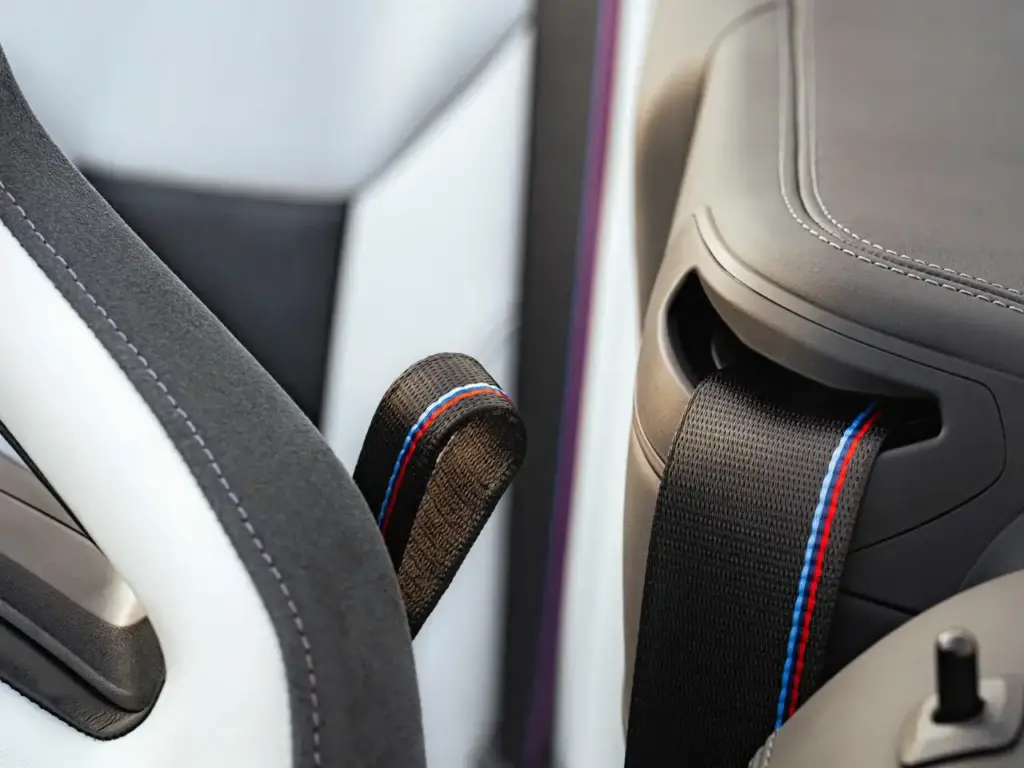
Competitive Comparison and Alternatives
BMW M4 vs Mercedes-AMG C63
| Specification | 2026 BMW M4 Competition | 2025 Mercedes-AMG C63 S |
|---|---|---|
| Engine | 3.0L twin-turbo I-6 | 4.0L twin-turbo V-8 + electric motor[13] |
| Horsepower | 523 hp | 671 hp |
| Torque | 479 lb-ft | 752 lb-ft |
| 0-60 mph | 3.4 seconds (xDrive) | 3.3 seconds |
| Weight | 3,627 lbs (1,645 kg) | 4,649 lbs (2,109 kg)[13] |
| Starting MSRP | $86,675 | $84,000 |
The new C63 adopts plug-in hybrid technology delivering massive power but adding significant weight. The M4 maintains traditional performance-car dynamics with lower mass and simpler drivetrain. Sound enthusiasts prefer the M4’s inline-six character over the C63’s muted hybrid exhaust note.
Mercedes counters with superior interior materials and more advanced autonomous driving features. Buyers prioritizing raw performance typically favor the M4’s engagement, while luxury-focused buyers lean toward Mercedes refinement.
BMW M4 vs Audi RS5
The Audi RS5 Sportback delivers 444 hp from a 2.9L twin-turbo V6 through standard Quattro all-wheel drive[14]. Key differences:
M4 advantages:
- 79 additional horsepower (Competition vs RS5)
- Rear-wheel-drive option for purist dynamics
- Manual transmission availability
- Lighter curb weight (approximately 200 pounds)
RS5 advantages:
- Sportback body style offering rear hatchback practicality
- More conservative exterior design aging gracefully
- Virtual Cockpit digital display praised for user interface
- Better fuel economy (17/26/20 mpg)[14]
Pricing proves similar with RS5 starting at $77,200. The RS5 suits buyers prioritizing daily usability and subtle performance, while the M4 serves track enthusiasts wanting maximum capability.
BMW M4 vs Cadillac CT4-V Blackwing
The Cadillac CT4-V Blackwing represents American high-performance at $62,990—$19,485 less than the base M4[15]. Its supercharged 3.6L V6 produces 472 hp through standard six-speed manual or optional 10-speed automatic.
Value proposition comparison:
- Blackwing offers 90% of M4 performance at 76% of the price
- Magnetic ride control suspension provides excellent balance
- More spacious interior with sedan practicality
- However, interior materials and technology lag BMW standards
- Resale value significantly weaker than German competitors
The Blackwing appeals to value-conscious enthusiasts willing to sacrifice brand prestige for performance-per-dollar. Comparing luxury brands reveals Cadillac’s positioning challenge despite strong product execution.
BMW M4 vs Porsche 911
The Porsche 911 Carrera ($116,000 starting) delivers similar performance from its rear-engine layout[16]. The 3.0L twin-turbo flat-six generates 379 hp, though numerous options easily push pricing beyond $140,000.
911 advantages:
- Legendary Porsche handling precision and balance
- Superior build quality and materials
- Stronger resale value retention (60-65% after 5 years)
- More engaging driving experience at moderate speeds
- Iconic design and brand cachet
M4 advantages:
- $30,000-$50,000 lower acquisition cost depending on options
- More powerful engines (473-523 hp vs 379-443 hp base/S)
- More practical rear seats and cargo space
- Better fuel economy
- Included maintenance reducing ownership costs
The 911 represents the segment’s gold standard, though its premium pricing positions it as aspirational upgrade rather than direct alternative for many M4 buyers.
Budget Alternative: Toyota Supra
The Toyota GR Supra shares BMW Z4 platform components including the B58 inline-six (non-M version of M4’s S58 engine)[17]. Starting at $56,450 with 382 hp, the Supra delivers 80% of M4’s performance at 68% of the cost.
Supra advantages:
- $26,025 lower entry price versus base M4
- Toyota reliability reputation and lower maintenance costs
- Nimbler handling from 400-pound weight advantage
- Lower insurance premiums
M4 advantages:
- 91-141 additional horsepower depending on trim
- Significantly more luxurious interior
- Advanced technology and driver assistance
- Manual transmission availability
- Better resale value and brand prestige
Budget-conscious enthusiasts find excellent value in the Supra, though buyers seeking ultimate performance and luxury justifiably spend extra for the M4.
BMW M3 vs M4: Which to Choose
The M3 sedan and M4 coupe share identical powertrains, chassis, and pricing, differing only in body style[18]:
| Characteristic | M3 Advantage | M4 Advantage |
|---|---|---|
| Practicality | Four doors, easier rear access | Two-door coupe styling |
| Weight | 55 pounds heavier | 55 pounds lighter |
| Rear seat usability | Adults fit comfortably | Children/emergency only |
| Styling | Subtle performance sedan | Aggressive coupe presence |
| Resale value | Slightly stronger demand | Niche market |
Buyers needing regular rear-seat transport should choose the M3 without question. The M4 serves childless enthusiasts or families with separate practical vehicles. Performance differences prove negligible—both deliver virtually identical acceleration and handling.
For buyers comparing BMW performance models, understanding BMW model differentiations helps clarify positioning across the lineup.
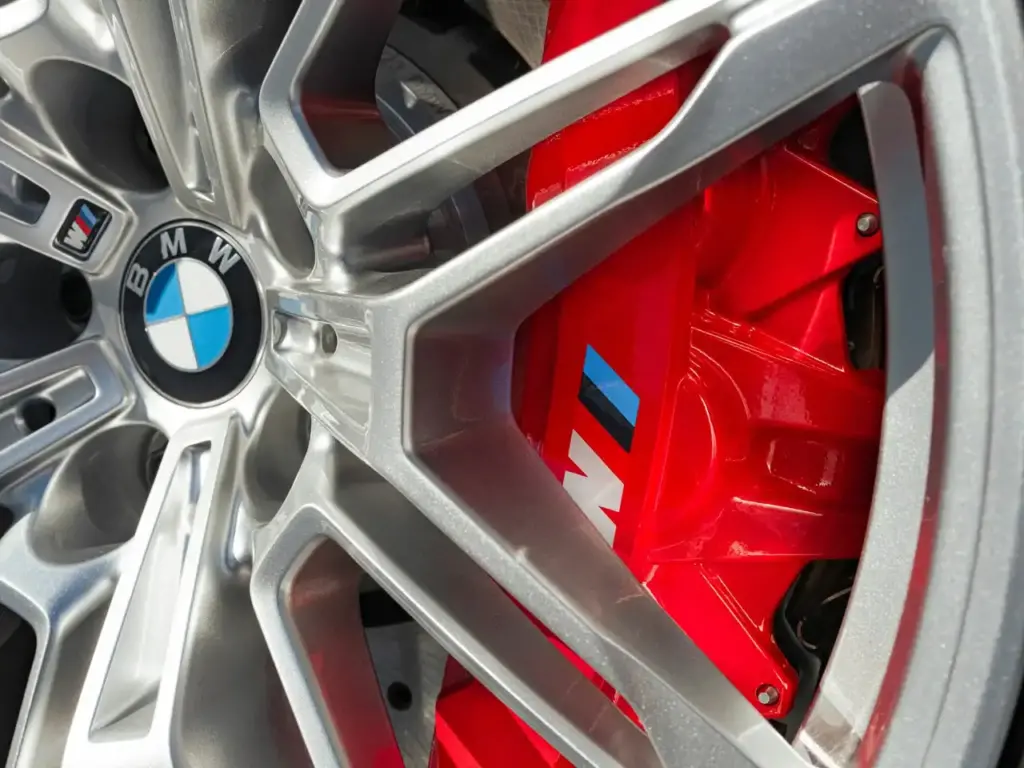
Is the 2026 BMW M4 Worth It?
Best Use Cases for the M4
The M4 excels in specific scenarios:
Weekend track warrior: Those logging 4-6 track days annually benefit from the M4’s capability, durability, and dealer support. The car handles repeated sessions without overheating or brake fade when properly equipped.
Manual transmission enthusiasts: Purists seeking one of the last available manual transmissions in the performance coupe segment find the base M4 uniquely appealing. With automatics dominating the market, manual availability may cease within 2-3 model cycles.
Performance-prioritizing singles or couples: Buyers without children or regular rear-passenger needs maximize the M4’s strengths while avoiding its practical compromises. The coupe body style provides sufficient cargo capacity for two-person weekend trips.
Brand loyalists upgrading: Long-time BMW owners familiar with M Division philosophy transition seamlessly to the M4’s driving dynamics and interface conventions.
Who Should Skip the M4
Certain buyer profiles should consider alternatives:
- Comfort-first luxury buyers: Those prioritizing ride quality and isolation will find the M4’s stiff suspension fatiguing during daily commuting. The 2026 BMW 540i delivers 70% of performance with superior comfort.
- Families requiring rear seats: Parents transporting children in rear-facing car seats or adolescents in booster seats face significant challenges with the M4’s cramped rear quarters and difficult access. The M3 sedan solves this completely.
- Budget-conscious buyers: The M4’s $82,475+ starting price, premium fuel requirements, expensive insurance, and rapid depreciation create high ownership costs. Value seekers should examine the Toyota Supra or Cadillac CT4-V Blackwing.
- Grille design objectors: Buyers fundamentally opposed to the controversial kidney grille design shouldn’t expect to warm to it over time. The styling represents polarizing design commitment rather than trend.
Value Analysis: Base vs Competition
The $4,200 premium for Competition trim delivers:
- 50 additional horsepower (473 hp → 523 hp)
- Upgraded 8-speed automatic transmission
- Enhanced M Sport exhaust system
- Shadowline exterior trim
- Competition-specific suspension tuning
This calculates to $84 per additional horsepower—reasonable compared to aftermarket tuning that voids warranty and creates reliability concerns. However, the automatic transmission eliminates manual availability, forcing engagement-focused buyers toward base specification.
Long-term ownership considerations:
- Competition models command higher resale values ($2,000-$3,000 premium on used market)
- Automatic transmission requires $600-$800 service every 60,000-80,000 miles
- Manual transmission clutch replacement costs $1,800-$2,400 at 40,000-60,000 miles depending on driving style
Track-focused buyers benefit from Competition’s additional power and quicker transmission. Daily drivers prioritizing engagement should choose the manual base model and invest savings in maintenance reserves or track-day expenses.
Final Verdict and Recommendation
The 2026 BMW M4 delivers authentic high-performance capability wrapped in luxury materials and advanced technology. It serves enthusiasts who prioritize driving engagement over comfort or practicality, offering one of the segment’s most rewarding experiences when driven aggressively.
Autvex recommends:
- Base manual M4 for purists wanting maximum engagement and the last available three-pedal performance coupe
- Competition xDrive for year-round performance in northern climates and maximum acceleration capability
- Competition coupe (RWD) for track enthusiasts in temperate climates seeking ideal power-to-weight and traditional dynamics
The M4’s primary competitor—the Mercedes-AMG C63—now adopts hybrid complexity adding weight and diminishing purity. This positions the M4 as the segment’s traditional performance standard, appealing to buyers who value driving feel over specification sheets.
According to Autvex market analysis, the M4 makes most sense for buyers who:
- Own additional vehicles for daily practicality
- Regularly attend track events or spirited driving opportunities
- Appreciate BMW M Division heritage and engineering
- Can accommodate stiff ride quality and sport-focused dynamics
For buyers requiring single-car versatility, the M3 sedan offers identical performance with vastly improved practicality. Those seeking similar performance with better value should examine the Toyota Supra, while luxury-focused buyers may prefer Mercedes or Audi alternatives despite performance compromises.
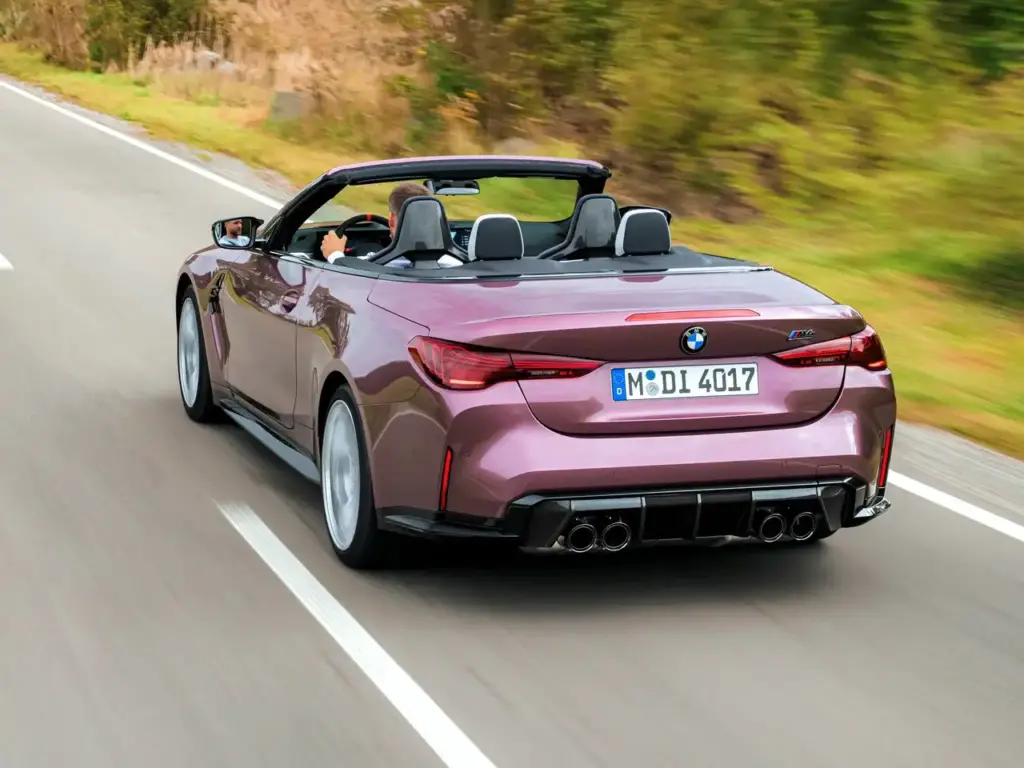
Key Takeaways
- The 2026 M4 starts at $82,475 with 473 hp, reaching $98,675 for Competition xDrive Convertible with 523 hp[1].
- Base models offer six-speed manual transmission—increasingly rare in performance segments and potentially discontinued after 2026-2027[1].
- Competition xDrive accelerates 0-60 mph in 3.4 seconds while achieving 29 mpg in highway testing[1].
- Stiff suspension prioritizes handling over comfort, creating rough ride on degraded pavement unsuitable for comfort-focused buyers[3].
- Rear seats accommodate children or emergency adult transport only; families should consider M3 sedan instead[7].
- BMW includes 4-year/50,000-mile warranty and 3-year/36,000-mile complimentary maintenance exceeding Mercedes-AMG and Audi coverage[1].
- Used M4s depreciate 54% over five years; buying 2-3 year old models saves $32,000-$44,000[12].
FAQs
How much does the 2026 BMW M4 cost?
The base M4 Coupe starts at $82,475, while Competition models begin at $86,675. The Competition xDrive Coupe costs $89,400, and the Competition xDrive Convertible tops the range at $98,675. Adding options can push prices beyond $110,000[1].
Is the BMW M4 Competition worth the extra money?
The Competition trim adds 50 horsepower, an automatic transmission, and enhanced exhaust for $4,200 premium. The upgrade proves worthwhile for buyers prioritizing maximum performance and faster acceleration. However, manual transmission enthusiasts must choose the base model[1].
Can you get a manual transmission in the 2026 M4?
Yes, the six-speed manual transmission comes standard on the base M4 Coupe with rear-wheel drive. Competition models exclusively offer the eight-speed automatic. The manual represents one of the last available in the luxury performance coupe segment[1].
What is the 0-60 time for the 2026 BMW M4?
Acceleration varies by configuration: base manual reaches 60 mph in 4.1 seconds, Competition automatic achieves 3.8 seconds, and Competition xDrive delivers the quickest time at 3.4 seconds. All models include launch control for optimal acceleration[1].
How reliable is the BMW M4?
Consumer Reports rates the 4 Series platform at 53/100 for predicted reliability—average for new vehicles. BMW’s brand reliability ranks 30th of 32 manufacturers. Common issues include PCV valve failures and turbocharger wastegate rattle, though the 4-year/50,000-mile warranty covers repairs[9][10].
What is the real-world fuel economy of the M4?
The EPA rates the M4 at 16/22-23/19 mpg city/highway/combined depending on configuration. Real-world highway testing achieved 29 mpg at steady speeds. Mixed driving typically returns 17-21 mpg, while aggressive driving drops efficiency to 12-14 mpg[1].
BMW M3 or M4: which is better?
The M3 and M4 share identical powertrains and pricing, differing only in body style. Choose the M3 sedan for rear-seat practicality and four-door convenience. Select the M4 coupe for styling and 55-pound weight advantage. Performance proves virtually identical between models[18].
Does the 2026 M4 come with all-wheel drive?
All-wheel drive is available exclusively on Competition trims as the xDrive system. The base M4 offers only rear-wheel drive. The xDrive system operates with rear bias, maintaining M car character while improving traction and acceleration[1].
What are the main competitors to the BMW M4?
Should I buy a new or used BMW M4?
Used M4s offer significant savings—2-3 year old models cost $32,000-$44,000 less than new while providing 25,000-35,000 miles of remaining life. Certified Pre-Owned models include extended warranty coverage. New buyers benefit from full warranty, complimentary maintenance, and latest technology[12].
References
- Car and Driver. (2025). 2026 BMW M4 Review, Pricing, and Specs. https://www.caranddriver.com/bmw/m4-2026
- BMW USA. (2025). BMW 4 Series Coupe M Models. https://www.bmwusa.com/vehicles/m-series/bmw-4-series-m-models/bmw-m4-coupe.html
- BMW Blog. (2025). 2026 BMW M4. https://www.bmwblog.com/2025/06/27/2026-bmw-m4-review-price-performance/
- Reddit. (2024). Manual vs automatic m4. https://www.reddit.com/r/BMW/comments/1dc5po8/manual_vs_automatic_m4/
- Car and Driver. (2021). 2021 BMW M4 Tested: Old-School Cool with New-School Speed. https://www.caranddriver.com/reviews/a35844313/2021-bmw-m4-drive/
- BMW Blog. (2020). The Design Story Behind the G80 M3 and G82 M4. https://www.bmwblog.com/2020/09/23/bmw-m3-m4-kidney-grille-design/
- Edmunds. (2025). 2026 BMW M4 Prices, Reviews, and Pictures. https://www.edmunds.com/bmw/m4/
- BMW of Springfield. (2025). 2026 BMW M4 Model Review. https://www.bmwofspringfield.com/bmw-reviews/2026-m4.htm
- NHTSA. (2025). Vehicle Detail Search – 2026 BMW M4 Coupe. https://www.nhtsa.gov/vehicle/2026/BMW/M4%20Coupe
- RepairPal. (2025). BMW M4 Reliability – 2025 Ratings. https://repairpal.com/reliability/bmw/m4
- EPA. (2025). Fuel Economy Data. https://www.fueleconomy.gov/
- CarEdge. (2024). BMW M4 Depreciation. https://caredge.com/bmw/m4/depreciation
- Mercedes-Benz USA. (2025). 2025 Mercedes-AMG C63 S E Performance. https://www.mbusa.com/en/vehicles/class/c-class/sedan
- Audi USA. (2025). 2026 Audi RS5 Sportback. https://www.audiusa.com/us/web/en/models/a5/rs5-sportback.html
- Cadillac. (2025). CT4-V Blackwing. https://www.cadillac.com/sedans/ct4-v-blackwing
- Porsche USA. (2025). 911 Carrera. https://www.porsche.com/usa/models/911/911-carrera-models/
- Toyota. (2025). GR Supra. https://www.toyota.com/grsupra/
- BMW USA. (2025). 2026 BMW 3 Series Sedan M Models. https://www.bmwusa.com/vehicles/m-series/m3-series/bmw-m3-sedan.html

I am a senior automotive analyst at Autvex. Expert vehicle evaluations, in-depth reviews, and objective analysis helping readers make informed automotive decisions with years of industry experience.

